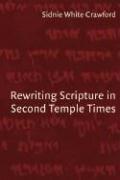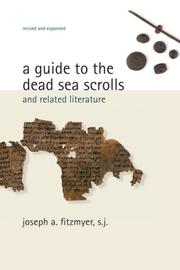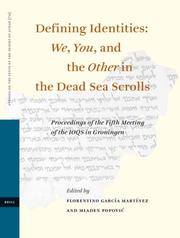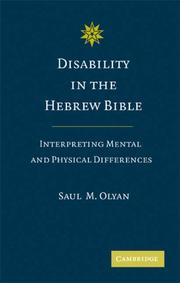| Listing 1 - 10 of 12 | << page >> |
Sort by
|

ISBN: 9780802847409 0802847404 Year: 2008 Publisher: Grand Rapids, Mich. Eerdmans
Abstract | Keywords | Export | Availability | Bookmark
 Loading...
Loading...Choose an application
- Reference Manager
- EndNote
- RefWorks (Direct export to RefWorks)
Bible --- Qumrân --- Dead Sea scrolls. --- 229*317 --- Qumran en het Oude Testament --- Jerusalem scrolls --- ʻAin Fashka scrolls --- Jericho scrolls --- Scrolls, Dead Sea --- Qumrân scrolls --- Rękopisy z Qumran --- Shikai bunsho --- Megilot Midbar Yehudah --- Dodezee-rollen --- Kumránské rukopisy --- Documentos de Qumrán --- Textos de Qumrán --- Rollos del Mar Muerto --- Manuscritos del Mar Muerto --- Manuscrits de la mer Morte --- Dödahavsrullarna --- Kumranin kirjoitukset --- Kuolleenmeren kirjoitukset --- Qumranhandskrifterna --- Qumranin kirjoitukset --- Qumran Caves scrolls --- 229*317 Qumran en het Oude Testament --- Qumran

ISBN: 9780802862419 0802862411 Year: 2008 Publisher: Grand Rapids Eerdmans
Abstract | Keywords | Export | Availability | Bookmark
 Loading...
Loading...Choose an application
- Reference Manager
- EndNote
- RefWorks (Direct export to RefWorks)
Bible --- Qumrân --- Dead Sea scrolls --- Bibliography. --- 229*3 --- Dode Zeerollen en intertestamentaire literatuur --- Jerusalem scrolls --- ʻAin Fashka scrolls --- Jericho scrolls --- Scrolls, Dead Sea --- Qumrân scrolls --- Rękopisy z Qumran --- Shikai bunsho --- Megilot Midbar Yehudah --- Dodezee-rollen --- Kumránské rukopisy --- Documentos de Qumrán --- Textos de Qumrán --- Rollos del Mar Muerto --- Manuscritos del Mar Muerto --- Manuscrits de la mer Morte --- Dödahavsrullarna --- Kumranin kirjoitukset --- Kuolleenmeren kirjoitukset --- Qumranhandskrifterna --- Qumranin kirjoitukset --- Qumran Caves scrolls --- 229*3 Dode Zeerollen en intertestamentaire literatuur --- Qumran

ISBN: 9789004164147 9004164146 9786611937157 1281937150 9047432479 9789047432470 9781281937155 6611937153 Year: 2008 Volume: 70 Publisher: Leiden Brill
Abstract | Keywords | Export | Availability | Bookmark
 Loading...
Loading...Choose an application
- Reference Manager
- EndNote
- RefWorks (Direct export to RefWorks)
This volume contains 15 of the papers read at the Fifth Meeting of the IOQS, celebrated in Groningen 27-28 July, 2004. The meeting focused on the identity formation of the group or groups represented in the Scrolls, explored issues of self-definition of Jewish groups in relation to, or in reaction towards other groups within Judaism (“sectarian” identity, inner-Jewish discourses and polemics), and inquired into the development of Jewish identity vis-à-vis other non-Jewish persons, groups or peoples as reflected in the Scrolls.
Academic collection --- Qumran community --- -Jews --- -229*310 --- Hebrews --- Israelites --- Jewish people --- Jewry --- Judaic people --- Judaists --- Ethnology --- Religious adherents --- Semites --- Judaism --- Kumran community --- Jewish sects --- Essenes --- Identity --- -Qumran --- Dead Sea scrolls --- Jerusalem scrolls --- ʻAin Fashka scrolls --- Jericho scrolls --- Scrolls, Dead Sea --- Qumrân scrolls --- Rękopisy z Qumran --- Shikai bunsho --- Megilot Midbar Yehudah --- Dodezee-rollen --- Kumránské rukopisy --- Documentos de Qumrán --- Textos de Qumrán --- Rollos del Mar Muerto --- Manuscritos del Mar Muerto --- Manuscrits de la mer Morte --- Dödahavsrullarna --- Kumranin kirjoitukset --- Kuolleenmeren kirjoitukset --- Qumranhandskrifterna --- Qumranin kirjoitukset --- Qumran Caves scrolls --- Conferences - Meetings --- 229*310 Qumran --- Qumran --- Jews --- 229*310
Book
ISBN: 9780802862853 0802862853 Year: 2008 Publisher: Grand Rapids Eerdmans
Abstract | Keywords | Export | Availability | Bookmark
 Loading...
Loading...Choose an application
- Reference Manager
- EndNote
- RefWorks (Direct export to RefWorks)
Maccabees --- History --- Sources. --- Dead Sea scrolls. --- -229*3 --- Asmoneans --- Hasmonaeans --- Hasmoneans --- Jews --- -Sources. --- Dode Zeerollen en intertestamentaire literatuur --- Jerusalem scrolls --- ʻAin Fashka scrolls --- Jericho scrolls --- Scrolls, Dead Sea --- Qumrân scrolls --- Rękopisy z Qumran --- Shikai bunsho --- Megilot Midbar Yehudah --- Dodezee-rollen --- Kumránské rukopisy --- Documentos de Qumrán --- Textos de Qumrán --- Rollos del Mar Muerto --- Manuscritos del Mar Muerto --- Manuscrits de la mer Morte --- Dödahavsrullarna --- Kumranin kirjoitukset --- Kuolleenmeren kirjoitukset --- Qumranhandskrifterna --- Qumranin kirjoitukset --- Qumran Caves scrolls --- 229*3 Dode Zeerollen en intertestamentaire literatuur --- 229*3 --- History&delete& --- Sources --- Maccabees - History - Sources.
Book
ISBN: 1589833910 9781589833913 9781589833906 1589833902 Year: 2008 Publisher: Atlanta Society of Biblical Literature
Abstract | Keywords | Export | Availability | Bookmark
 Loading...
Loading...Choose an application
- Reference Manager
- EndNote
- RefWorks (Direct export to RefWorks)
Judaism --- Hellenistic Judaism --- Judaism, Hellenistic --- History --- Noah --- נח --- Dead Sea scrolls. --- Jerusalem scrolls --- ʻAin Fashka scrolls --- Jericho scrolls --- Scrolls, Dead Sea --- Qumrân scrolls --- Rękopisy z Qumran --- Shikai bunsho --- Megilot Midbar Yehudah --- Dodezee-rollen --- Kumránské rukopisy --- Documentos de Qumrán --- Textos de Qumrán --- Rollos del Mar Muerto --- Manuscritos del Mar Muerto --- Manuscrits de la mer Morte --- Dödahavsrullarna --- Kumranin kirjoitukset --- Kuolleenmeren kirjoitukset --- Qumranhandskrifterna --- Qumranin kirjoitukset --- Qumran Caves scrolls --- 229*317 --- 229*317 Qumran en het Oude Testament --- Qumran en het Oude Testament
Book
ISBN: 9782204086912 2204086916 Year: 2008 Publisher: Paris Cerf
Abstract | Keywords | Export | Availability | Bookmark
 Loading...
Loading...Choose an application
- Reference Manager
- EndNote
- RefWorks (Direct export to RefWorks)
Qumrân --- Essenes --- Qumran community --- Esséniens --- Communauté de Qumran --- Dead Sea scrolls --- History --- Qumran Site (West Bank) --- Qumran (Cisjordanie : Site archéologique) --- 229*316.2 --- Qumran-secte en Essenen --- 229*316.2 Qumran-secte en Essenen --- Esséniens --- Communauté de Qumrān --- Qumrān (Cisjordanie : Site archéologique) --- Archaeology - Dead Sea Scrolls - Hebrew Bible - Origins of Christianity. --- Kumran community --- Jewish sects --- Dead Sea scrolls. --- Jerusalem scrolls --- ʻAin Fashka scrolls --- Jericho scrolls --- Scrolls, Dead Sea --- Qumrân scrolls --- Rękopisy z Qumran --- Shikai bunsho --- Megilot Midbar Yehudah --- Dodezee-rollen --- Kumránské rukopisy --- Documentos de Qumrán --- Textos de Qumrán --- Rollos del Mar Muerto --- Manuscritos del Mar Muerto --- Manuscrits de la mer Morte --- Dödahavsrullarna --- Kumranin kirjoitukset --- Kuolleenmeren kirjoitukset --- Qumranhandskrifterna --- Qumranin kirjoitukset --- Qumran Caves scrolls --- Qumran

ISBN: 9780521888073 9780511499036 9781107404984 9780511409929 0511409923 9780511408021 0511408021 9780511409387 0511409389 9780511408816 0511408811 0511499035 1281717096 9781281717092 0521888077 1107404983 1107187265 9781107187269 9786611717094 6611717099 0511407289 9780511407284 Year: 2008 Publisher: Cambridge New York Cambridge University Press
Abstract | Keywords | Export | Availability | Bookmark
 Loading...
Loading...Choose an application
- Reference Manager
- EndNote
- RefWorks (Direct export to RefWorks)
Mental and physical disability, ubiquitous in texts of the Hebrew Bible, here receive a thorough treatment. Olyan seeks to reconstruct the Hebrew Bible's particular ideas of what is disabling and their potential social ramifications. Biblical representations of disability and biblical classification schemas - both explicit and implicit - are compared to those of the Hebrew Bible's larger ancient West Asian cultural context, and to those of the later Jewish biblical interpreters who produced the Dead Sea Scrolls. This study will help the reader gain a deeper and more subtle understanding of the ways in which biblical writers constructed hierarchically significant difference and privileged certain groups (e.g. persons with 'whole' bodies) over others (e.g. persons with physical 'defects'). It also explores how ancient interpreters of the Hebrew Bible such as the Qumran sectarians reproduced and reconfigured earlier biblical notions of disability and earlier classification models for their own contexts and ends.
People with disabilities in rabbinical literature --- People with disabilities in the Bible --- 221.08*3 --- Handicapped in the Bible --- Handicapped in rabbinical literature --- Rabbinical literature --- 221.08*3 Theologie van het Oude Testament: themata --- Theologie van het Oude Testament: themata --- Bible. --- Dead Sea scrolls. --- Antico Testamento --- Hebrew Bible --- Hebrew Scriptures --- Kitve-ḳodesh --- Miḳra --- Old Testament --- Palaia Diathēkē --- Pentateuch, Prophets, and Hagiographa --- Sean-Tiomna --- Stary Testament --- Tanakh --- Tawrāt --- Torah, Neviʼim, Ketuvim --- Torah, Neviʼim u-Khetuvim --- Velho Testamento --- Jerusalem scrolls --- ʻAin Fashka scrolls --- Jericho scrolls --- Scrolls, Dead Sea --- Qumrân scrolls --- Rękopisy z Qumran --- Shikai bunsho --- Megilot Midbar Yehudah --- Dodezee-rollen --- Kumránské rukopisy --- Documentos de Qumrán --- Textos de Qumrán --- Rollos del Mar Muerto --- Manuscritos del Mar Muerto --- Manuscrits de la mer Morte --- Dödahavsrullarna --- Kumranin kirjoitukset --- Kuolleenmeren kirjoitukset --- Qumranhandskrifterna --- Qumranin kirjoitukset --- Qumran Caves scrolls --- Criticism, interpretation, etc. --- People with disabilities in the Bible. --- People with disabilities in rabbinical literature. --- Arts and Humanities --- Religion
Book
ISBN: 9789004165823 9004165827 9786612398230 1282398237 9047442474 9789047442479 661239823X Year: 2008 Volume: 126 Publisher: Leiden Brill
Abstract | Keywords | Export | Availability | Bookmark
 Loading...
Loading...Choose an application
- Reference Manager
- EndNote
- RefWorks (Direct export to RefWorks)
Altogether 46 essays in honour of Professor Raija Sollamo contribute to explore various aspects of the rich textual material around the turn of the era. At that time Scripture was not yet fixed; various writings and collections of writings were considered authoritative but their form was more or less in transition. The appearance of the first biblical translations are part of this transitional process. The Septuagint in particular provides us evidence and concrete examples of those textual traditions and interpretations that were in use in various communities. Furthermore, several biblical concepts, themes and writings were reinterpreted and actualised in the Dead Sea Scrolls, illuminating the transitions that took place in one faction of Judaism. The topics of the contributions are divided into five parts: Translation and Interpretation; Textual History; Hebrew and Greek Linguistics; Dead Sea Scrolls; Present-Day.
Hebrew language --- Greek language, Biblical --- Grammar --- Bible --- Dead Sea scrolls --- Versions --- Septuagint --- Language, style --- Translating --- 221 <082> --- 221.02 --- Grammar. --- Bijbel: Oud Testament--Feestbundels. Festschriften --- Oud Testament: bijbelse filologie --- Bible. --- Dead Sea scrolls. --- Jerusalem scrolls --- ʻAin Fashka scrolls --- Jericho scrolls --- Scrolls, Dead Sea --- Qumrân scrolls --- Rękopisy z Qumran --- Shikai bunsho --- Megilot Midbar Yehudah --- Dodezee-rollen --- Kumránské rukopisy --- Documentos de Qumrán --- Textos de Qumrán --- Rollos del Mar Muerto --- Manuscritos del Mar Muerto --- Manuscrits de la mer Morte --- Dödahavsrullarna --- Kumranin kirjoitukset --- Kuolleenmeren kirjoitukset --- Qumranhandskrifterna --- Qumranin kirjoitukset --- Qumran Caves scrolls --- Chʻuraegŭpki (Book of the Old Testament) --- Exodus (Book of the Old Testament) --- Khurūj --- Kitāb-i Shimūt (Book of the Old Testament) --- Shemot --- Sifr al-Khurūj (Book of the Old Testament) --- Be-reshit (Book of the Old Testament) --- Bereshit (Book of the Old Testament) --- Bytie (Book of the Old Testament) --- Chʻangsegi (Book of the Old Testament) --- Genesis (Book of the Old Testament) --- Sifr al-Takwīn --- Takwīn (Book of the Old Testament) --- Septuagint. --- Language, style. --- Translating. --- Festschrift - Libri Amicorum --- Hébreu (Langue) --- Grec biblique --- Grammaire --- Übersetzung. --- Bibel. --- Qumrantexte. --- Griechisch. --- Hebräisch. --- Shemos --- Hebrew language - Grammar --- Greek language, Biblical - Grammar
Book
ISSN: 13842161 ISBN: 9789004165663 9004165665 9786612398193 1282398199 9047433149 9789047433149 9781282398191 6612398191 Year: 2008 Volume: 125 Publisher: Leiden Boston Brill
Abstract | Keywords | Export | Availability | Bookmark
 Loading...
Loading...Choose an application
- Reference Manager
- EndNote
- RefWorks (Direct export to RefWorks)
This volume considers a major shift among Jewish sages during the Second Temple period, as certain authors moved from an earthly focus to a belief in individual immortality. Egyptian instructions and the book of Proverbs are examined for necessary background. The colorful responses of Qoheleth and Ben Sira to an emergent belief in the afterlife are also discussed. 4QInstruction, the largest Wisdom text from the Dead Sea Scrolls corpus, demonstrates this shift to an eschatological understanding. This book considers the diverse reasons for the changes that one finds in 4QInstruction, especially the issue of social context. It will prove useful to those interested in Wisdom literature, the Dead Sea Scrolls, apocalypticism, and the development of beliefs in the afterlife.
Future life --- Immortality --- Eschatology, Jewish --- Judaism --- Rabbinical literature --- History --- History and criticism --- Bible. --- Dead Sea scrolls --- Criticism, interpretation, etc. --- 223.4 --- 223.5 --- 223.7 --- Boek der Spreuken --- Prediker. Qohelet (Ecclesiastes) --- Wijsheid. Wijsheid van Jesus Sirach (Ecclesiasticus) --- Hellenistic Judaism --- Judaism, Hellenistic --- Life after death --- Eschatology --- Immortalism --- Dead Sea scrolls. --- Jerusalem scrolls --- ʻAin Fashka scrolls --- Jericho scrolls --- Scrolls, Dead Sea --- Qumrân scrolls --- Rękopisy z Qumran --- Shikai bunsho --- Megilot Midbar Yehudah --- Dodezee-rollen --- Kumránské rukopisy --- Documentos de Qumrán --- Textos de Qumrán --- Rollos del Mar Muerto --- Manuscritos del Mar Muerto --- Manuscrits de la mer Morte --- Dödahavsrullarna --- Kumranin kirjoitukset --- Kuolleenmeren kirjoitukset --- Qumranhandskrifterna --- Qumranin kirjoitukset --- Qumran Caves scrolls --- Antico Testamento --- Hebrew Bible --- Hebrew Scriptures --- Kitve-ḳodesh --- Miḳra --- Old Testament --- Palaia Diathēkē --- Pentateuch, Prophets, and Hagiographa --- Sean-Tiomna --- Stary Testament --- Tanakh --- Tawrāt --- Torah, Neviʼim, Ketuvim --- Torah, Neviʼim u-Khetuvim --- Velho Testamento --- Eschatology, Jewish. --- Judaism. --- History and criticism. --- Future life - Judaism --- Immortality - Judaism --- Judaism - History - Post-exilic period, 586 B.C.-210 A.D. --- Rabbinical literature - History and criticism
Book
ISSN: 01699962 ISBN: 9789004170889 900417088X 9786612400100 128240010X 9047424190 9789047424192 Year: 2008 Volume: v. 78 Publisher: Leiden Brill
Abstract | Keywords | Export | Availability | Bookmark
 Loading...
Loading...Choose an application
- Reference Manager
- EndNote
- RefWorks (Direct export to RefWorks)
Rather than being an isolated, primitive body of knowledge the Jewish calendar tradition of 364 days constituted an integral part of the astronomical science of the ancient world. This tradition—attested in the Dead Sea Scrolls and in the Pseudepigrapha—stands out as a coherent, novel synthesis, representing the Jewish authors’ apocalyptic worldview. The calendar is studied here both “from within”—analyzing its textual manifestations —and “from without”—via a comparison with ancient Mesopotamian astronomy. This analysis reveals that the calendrical realm constituted a significant case of inter-cultural borrowing, pertinent to similar such cases in ancient literature. Special attention is given to the “Book of Astronomy” (1 Enoch 72-82) and a variety of calendrical and liturgical texts from Qumran.
Calendar, Jewish --- Jewish astronomy. --- Apocryphal books (Old Testament) --- 229*319 --- 229*209 --- 229*209 I Henoch (Ethiopische Henoch) --- I Henoch (Ethiopische Henoch) --- 229*319 Qumran en het jodendom --- Qumran en het jodendom --- Astronomy, Jewish --- Hebrew astronomy --- Astronomy --- Calendar, Hebrew --- Hebrew calendar --- Calendar --- Jewish chronology --- History. --- Criticism, interpretation, etc. --- History and criticism --- Dead Sea scrolls. --- Ethiopic book of Enoch --- Book of Enoch, Ethiopic --- Enoch, Ethiopic Book of --- Book of the Ethiopic Enoch --- Äthiopischer Henoch --- Buch Henoch --- Bible. --- 1 Enoch (Apocryphal book) --- First Enoch (Apocryphal book) --- 1st Enoch (Apocryphal book) --- Jerusalem scrolls --- ʻAin Fashka scrolls --- Jericho scrolls --- Scrolls, Dead Sea --- Qumrân scrolls --- Rękopisy z Qumran --- Shikai bunsho --- Megilot Midbar Yehudah --- Dodezee-rollen --- Kumránské rukopisy --- Documentos de Qumrán --- Textos de Qumrán --- Rollos del Mar Muerto --- Manuscritos del Mar Muerto --- Manuscrits de la mer Morte --- Dödahavsrullarna --- Kumranin kirjoitukset --- Kuolleenmeren kirjoitukset --- Qumranhandskrifterna --- Qumranin kirjoitukset --- Qumran Caves scrolls --- Jewish calendar --- Calendrier juif --- Astronomie juive --- Apocryphes (Ancient Testament) --- History --- Histoire --- Critique, interprétation, etc --- Jewish astronomy --- Criticism, interpretation, etc
| Listing 1 - 10 of 12 | << page >> |
Sort by
|

 Search
Search Feedback
Feedback About UniCat
About UniCat  Help
Help News
News